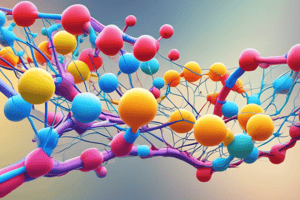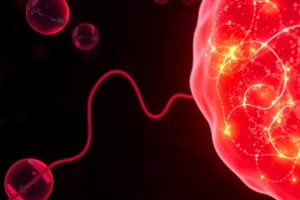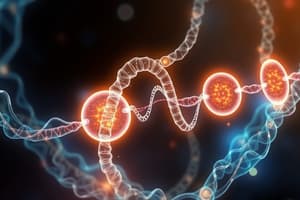Podcast
Questions and Answers
Which of the following is the primary reason cancer cells upregulate glycolysis, even in the presence of oxygen, a phenomenon known as the Warburg effect?
Which of the following is the primary reason cancer cells upregulate glycolysis, even in the presence of oxygen, a phenomenon known as the Warburg effect?
- To reduce the production of reactive oxygen species (ROS).
- To maximize ATP production through oxidative phosphorylation.
- To provide building blocks for rapid cell growth and proliferation. (correct)
- To generate more lactate, which inhibits immune cell activity around the tumor.
Glycolysis occurs in the mitochondria of eukaryotic cells.
Glycolysis occurs in the mitochondria of eukaryotic cells.
False (B)
What molecule is regenerated during the conversion of pyruvate to lactate in anaerobic glycolysis, allowing glycolysis to continue?
What molecule is regenerated during the conversion of pyruvate to lactate in anaerobic glycolysis, allowing glycolysis to continue?
NAD+
In erythrocytes, 1,3-BPG is converted to __________, which binds to hemoglobin and reduces its affinity for oxygen.
In erythrocytes, 1,3-BPG is converted to __________, which binds to hemoglobin and reduces its affinity for oxygen.
Match each enzyme with its primary regulatory role in glycolysis:
Match each enzyme with its primary regulatory role in glycolysis:
During intense exercise, the Cori cycle helps to:
During intense exercise, the Cori cycle helps to:
Glucokinase, an isozyme of hexokinase found in the liver, is inhibited by glucose-6-phosphate.
Glucokinase, an isozyme of hexokinase found in the liver, is inhibited by glucose-6-phosphate.
What is the net ATP production from one glucose molecule that undergoes glycolysis?
What is the net ATP production from one glucose molecule that undergoes glycolysis?
Which enzyme catalyzes the conversion of fructose-6-phosphate to fructose-1,6-bisphosphate, a key regulatory step in glycolysis?
Which enzyme catalyzes the conversion of fructose-6-phosphate to fructose-1,6-bisphosphate, a key regulatory step in glycolysis?
Under aerobic conditions, pyruvate is converted to __________, which then enters the citric acid cycle.
Under aerobic conditions, pyruvate is converted to __________, which then enters the citric acid cycle.
Flashcards
What is Glycolysis?
What is Glycolysis?
Metabolic pathway converting glucose to pyruvate or lactate, producing ATP. Occurs in the cytoplasm and doesn't require oxygen.
Energy Investment Phase
Energy Investment Phase
The initial stage of glycolysis where ATP is used to phosphorylate glucose and its intermediates, preparing them for later reactions.
Energy Payoff Phase
Energy Payoff Phase
The later stage of glycolysis where ATP and NADH are produced, yielding a net energy gain for the cell.
Hexokinase/Glucokinase
Hexokinase/Glucokinase
Signup and view all the flashcards
Phosphofructokinase-1 (PFK-1)
Phosphofructokinase-1 (PFK-1)
Signup and view all the flashcards
Phosphoglycerate Kinase
Phosphoglycerate Kinase
Signup and view all the flashcards
Pyruvate Kinase
Pyruvate Kinase
Signup and view all the flashcards
Anaerobic Glycolysis
Anaerobic Glycolysis
Signup and view all the flashcards
Hexokinase I-III
Hexokinase I-III
Signup and view all the flashcards
Cori Cycle
Cori Cycle
Signup and view all the flashcards
Study Notes
- Glycolysis is a metabolic pathway that converts glucose into pyruvate or lactate and produces ATP
- It occurs in the cytoplasm of cells
- Glycolysis does not require oxygen, making it an anaerobic process
- It is a fundamental pathway in most organisms for energy production
Phases of Glycolysis
- Glycolysis is divided into two main phases: the energy investment phase and the energy payoff phase
Energy Investment Phase
- This phase consumes ATP to phosphorylate glucose and its intermediates
- Glucose is phosphorylated by hexokinase or glucokinase to form glucose-6-phosphate (G6P), consuming one ATP
- G6P is isomerized to fructose-6-phosphate (F6P) by phosphoglucose isomerase
- F6P is phosphorylated by phosphofructokinase-1 (PFK-1) to form fructose-1,6-bisphosphate (F-1,6-BP), consuming another ATP. PFK-1 is a key regulatory enzyme in glycolysis
- F-1,6-BP is cleaved by aldolase into two 3-carbon molecules: dihydroxyacetone phosphate (DHAP) and glyceraldehyde-3-phosphate (G3P)
- DHAP is isomerized to G3P by triose phosphate isomerase, resulting in two molecules of G3P
Energy Payoff Phase
- This phase produces ATP and NADH
- G3P is oxidized and phosphorylated by glyceraldehyde-3-phosphate dehydrogenase (GAPDH) to form 1,3-bisphosphoglycerate (1,3-BPG). This reaction also reduces NAD+ to NADH
- 1,3-BPG transfers a phosphate group to ADP, forming ATP and 3-phosphoglycerate (3PG) via phosphoglycerate kinase. This is substrate-level phosphorylation
- 3PG is isomerized to 2-phosphoglycerate (2PG) by phosphoglycerate mutase
- 2PG is dehydrated to phosphoenolpyruvate (PEP) by enolase
- PEP transfers a phosphate group to ADP, forming ATP and pyruvate via pyruvate kinase. This is another substrate-level phosphorylation
Net Reaction of Glycolysis
- Glucose + 2 NAD+ + 2 ADP + 2 Pi → 2 Pyruvate + 2 NADH + 2 ATP + 2 H2O + 2 H+
- For each molecule of glucose, glycolysis yields a net gain of 2 ATP molecules, 2 NADH molecules, and 2 pyruvate molecules
Fate of Pyruvate
- Depending on the presence of oxygen, pyruvate can undergo different fates
- Under aerobic conditions, pyruvate is transported into the mitochondria and converted to acetyl-CoA, which enters the citric acid cycle for further oxidation
- Under anaerobic conditions, pyruvate is reduced to lactate by lactate dehydrogenase, regenerating NAD+ for glycolysis to continue. This process is called fermentation
- In yeast, pyruvate can be converted to ethanol and CO2 in a process called alcoholic fermentation
Regulation of Glycolysis
- Glycolysis is tightly regulated to meet the energy needs of the cell
- The key regulatory enzymes are hexokinase, phosphofructokinase-1 (PFK-1), and pyruvate kinase
- Hexokinase is inhibited by glucose-6-phosphate
- PFK-1 is the most important regulatory enzyme. It is allosterically activated by AMP and fructose-2,6-bisphosphate (F-2,6-BP) and inhibited by ATP and citrate
- Pyruvate kinase is activated by fructose-1,6-bisphosphate and inhibited by ATP and alanine
Isozymes of Hexokinase
- There are four isozymes of hexokinase (I-IV)
- Hexokinase I, II, and III have high affinity for glucose and are inhibited by glucose-6-phosphate
- Hexokinase IV (glucokinase) is found in the liver and pancreatic β-cells. It has a lower affinity for glucose and is not inhibited by glucose-6-phosphate. Glucokinase helps regulate blood glucose levels
Energetics of Glycolysis
- The energy investment phase consumes 2 ATP molecules
- The energy payoff phase produces 4 ATP molecules and 2 NADH molecules
- The net ATP production is 2 ATP molecules per glucose molecule
- The 2 NADH molecules can be used in the electron transport chain to produce additional ATP under aerobic conditions
Importance of Glycolysis
- Provides ATP for cellular energy needs
- Generates pyruvate, which can be further oxidized in the citric acid cycle under aerobic conditions
- Generates NADH, which can be used in the electron transport chain to produce ATP under aerobic conditions
- Provides precursors for other metabolic pathways, such as amino acid synthesis and lipid synthesis
Glycolysis in Erythrocytes
- Red blood cells rely solely on glycolysis for ATP production because they lack mitochondria
- In erythrocytes, the first step in glycolysis is Glucose -> Glucose-6-Phosphate, by glucokinase
- A unique step in erythrocytes is the conversion of 1,3-BPG to 2,3-BPG by bisphosphoglycerate mutase
- 2,3-BPG binds to hemoglobin and reduces its affinity for oxygen, facilitating oxygen release in tissues
- 2,3-BPG is converted back to 3-PG
Clinical Significance
- Cancer cells rely heavily on glycolysis for energy, even in the presence of oxygen (Warburg effect)
- Glycolytic enzymes are potential targets for cancer therapy
- Genetic defects in glycolytic enzymes can cause hemolytic anemia due to impaired ATP production in red blood cells
- Understanding glycolysis is crucial for managing metabolic disorders such as diabetes
Anaerobic Glycolysis
- In the absence of oxygen, pyruvate is converted to lactate in a process called anaerobic glycolysis or fermentation
- Lactate dehydrogenase (LDH) catalyzes the reduction of pyruvate to lactate, regenerating NAD+ for glycolysis to continue
- Anaerobic glycolysis allows ATP production to continue when oxygen is limited, such as during intense exercise
- However, anaerobic glycolysis is less efficient than aerobic respiration and leads to the accumulation of lactate, which can cause muscle fatigue and acidosis
Cori Cycle
- The Cori cycle is a metabolic pathway in which lactate produced by anaerobic glycolysis in muscles is transported to the liver
- In the liver, lactate is converted back to glucose through gluconeogenesis, which requires ATP
- The glucose is then released back into the bloodstream and transported back to the muscles
- The Cori cycle helps to recycle lactate and maintain blood glucose levels during intense exercise
Studying That Suits You
Use AI to generate personalized quizzes and flashcards to suit your learning preferences.




